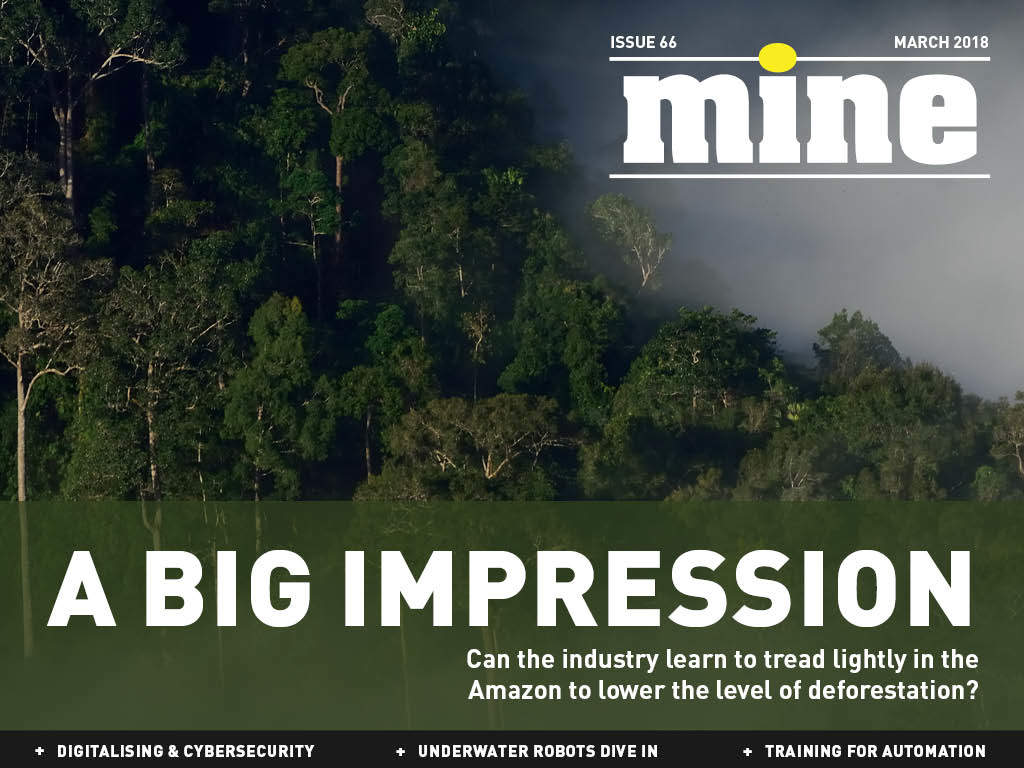
Mining caused around 10% of all Amazon deforestation between 2005 and 2015, according to a study by researchers at the University of Vermont. Although previously claimed to be just 1%-2%, this hadn’t included mining-related deforestation up to 70km beyond site borders to make way for roads, railways, accommodation and agriculture.
In this issue, we assess the components of mining’s environmental footprint in the Amazon rainforest, to understand the real scale, and discover what can be done to improve the situation.
Also, we look at the projects using innovative solutions to mine waste and the reuse of tailings, profile Mexico’s mining industry as it gets ready for a solid recovery, and learn about the underwater robots that can access flooded, abandoned mines.
Plus, we hear how Rio Tinto is effectively training workers for the automated future, and speak with Ernst & Young on the industry’s vulnerabilities and how to protect against digital risk.
Read MINE magazine free on iPad through our app and on desktop, and you can join the conversation on Twitter.
In this issue
Mining in Mexico: a strong recovery?
Analysis by BMI Research predicts that Mexico’s mining industry will enjoy one of the fastest recoveries in Latin America due to the strong price performance of its key commodities, gold, silver and zinc, along with a strong pipeline of projects and supportive policy/regulatory atmosphere. MINE profiles Mexico’s mining sector and its prospects.
Mining’s big footprints in the Amazon
A new study published by researchers at the University of Vermont has found that mining caused around 10% of all Amazon deforestation between 2005 and 2015. Previous estimates put this figure at only 1%-2%, so the problem may be far worse than previously thought, with mining-related deforestation often occurring up to 70km outside of mine borders to make room for roads, railways, worker accommodation and more. What are the major components of mining’s environmental footprint in the Amazon rainforest and what can be done to improve the situation?
Reinventing mining waste
Tailings and other waste represent one of the mining industry’s most enduring environmental hazards. MINE rounds up some of the most innovative modern approaches to reducing and reinventing the industry’s leavings, from the miners searching historic silver mine tailings for valuable cobalt, to major waste reduction initiatives and even a plan to build new roads from the waste rock of gold mines in Yukon, Canada.
Training for an automated future
As the mining industry becomes increasingly automated the skills gap is growing. Rio Tinto has announced a $2m Vocational Education and Training initiative to try to tackle this gap, ensuring that the next generation of miners are properly prepared for working in the digital era of mining. We talked to Rio Tinto to find out what skills a modern miner needs.
VAMOS: unlocking abandoned mine sites with underwater robots
The EU’s Viable Alternative Mine Operating System (VAMOS) project aims to prove the effectiveness of using underwater mining robots to access abandoned, flooded mine sites that would be otherwise be too dangerous or unfeasible to work on. A demonstration project at Whitehill Yeo pit in Devon was completed in October and a second trial in Bosnia and Herzegovina is planned for later this year. We see how the system works and what it could mean for accessing cut off resources.
Digital risk: every miner’s worst nightmare?
EY research suggest that, as companies strive to improve productivity by introducing new technologies, the convergence of information technology and operational technology has made companies more vulnerable to rogue activity. Put plainly, the industry has become a target for hackers. So what can be done? We speak to EY to find out how miners are catching up with concept of digital risk.
In the next issue
The Democratic Republic of Congo is rarely far from controversy and that’s not about to change. State-owned firm Gécamines has called for an overhaul of the country’s mining code, saying it doesn’t enable the country to benefit from its own resources. Is it time for an update? We explore how this could benefit the Congolese people and the potential impact on foreign investment.
We also delve into the details of Canada’s ‘Towards Sustainable Mining’ initiative, ask how much tin is at the bottom of the Cornish sea, find out about a project to create the first deposit database, and speak to risk management consultancy Critical Resource about political risk in the 21st Century.
Plus, from the humble wooden cart to modern day unmanned electric vehicles, we trace the evolution of mining machines through time and celebrate the industry’s achievements in cutting edge technology.
Digital Magazine FAQs
You can read MINE for free on the iPad. Download our app from the App Store to read the latest issue and browse the back issues in our archive.
You can also continue to read the desktop version for free on our web viewer. (Browser compatibility: The web viewer works in the latest two version of Chrome, Firefox and Safari, as well as in Internet Explorer 9 and 10. Some features may not be compatible with older browser versions).



